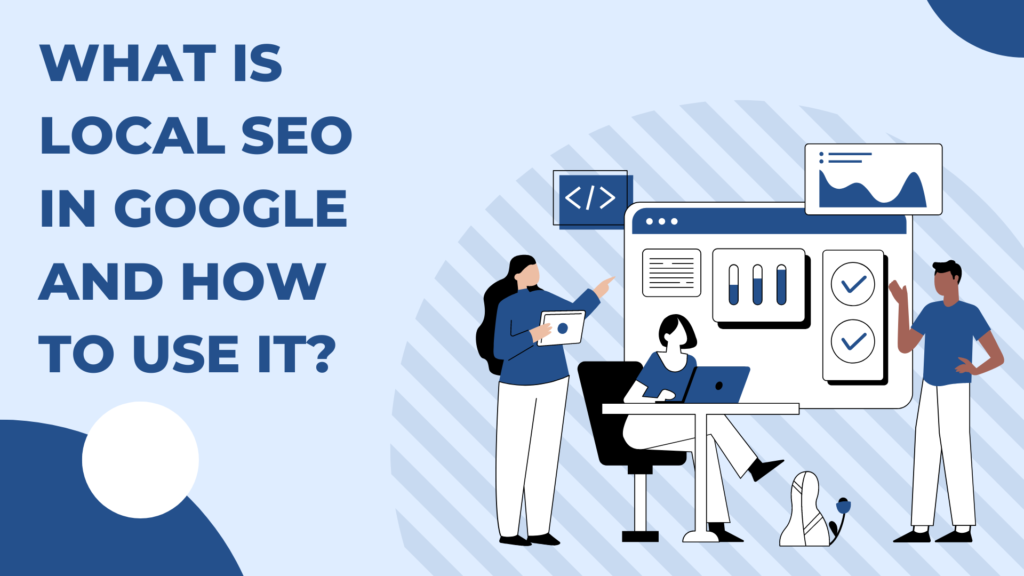Search results are becoming more and more personalized. One of the personalization factors is the user’s location. Google shows information on maps and in quick answers about companies that are geographically closer to this location. To get more local traffic or applications/sales, you will need local SEO.
In this article, we will look at what local SEO is and how to use it correctly.
Definition of local SEO
Local SEO is a promotion strategy aimed at increasing brand awareness, leads and deals in your area, geographically as close to the company as possible. This method is suitable for companies with a physical office, which is not just a workplace for employees, but a place of sales (cafes, restaurants, bars, hairdressers, stores, etc.).
According to foreign colleagues , 90% of purchases in the US are made in physical stores, and people spend 80% of their income within 25 kilometers of home. No similar research has been conducted in Russia and the CIS countries, but most likely the overall picture does not change.
Google Local SEO: Ranking Factors
Local website optimization methods can be external and internal.
Internal ranking factors
Google is a commercial company. Investors expect it to make a profit.
Local SEO is one example of Google wanting to keep the user inside the search results, thereby getting a larger share of traffic. It “selects” the map and route map, shows addresses, and also gives the opportunity to call the company directly from the results. Therefore, using local SEO techniques, you can feel a drop in traffic, but get more leads.
Local Search Result Types
There are 3 types of ranking results:
- local organic search results:
- Google Local Pack is the first 3 results from Google Maps:
- Local Knowledge Graph – usually these are results from direct vital queries:
Creating content for local queries
There are some difficulties with some geographically based queries:
- breadth of geography. It is impossible to understand how broadly the user is searching. The request can be addressed to a country, city, region, and even a specific postal code;
- explicit and implicit geolocation. A request with a toponym is explicit, while a request without specifying a location is implicit. Implicit ones are further subdivided into two types: those that strongly depend on the territorial proximity to the user and requests with low correlation.
Previously, local queries were accompanied by “tails”: “near me” , “nearest” , “where” , keys with a toponym, and others. Now even this is not necessary:
In order for search engines to easily and accurately determine the geographic location, you need to create site content according to special rules.
Optimizing <title> and <description> tags
In addition to general recommendations (title — no more than 70 characters, and description — 160-200 characters), you need to include toponyms in them. This way you will be able to rank for queries with explicit and implicit geolocation.
Name, address, phone (NAP)
Name, address and phone number are the most important parameters. Be sure to include the name so that you can be found by brand queries.
Make sure that the address is specified in the same format. “Ul” and “street” are treated as different addresses. Also watch this on third-party sites.
Phone – must be marked with micro-markup (read below) and clickable. So the user will be able to call directly from the search results.
Specialized pages for locations
Google ranks pages, not websites. So feel free to create separate landing pages for specific locations. For example, the address of a store in a certain area. In addition, the range of products may differ. By indicating this on the site, you will be able to attract more users, and therefore improve your positions.
Implementing micro-markup for rich snippets
Before landing on a site, search results may show a snippet relevant to its query. In the case of vital and geographically related queries, such snippets appear almost always.
The attractiveness and informativeness of the snippet directly affects the click-through rate (CTR). High click-through rate gives a signal to the search engine about the usefulness of the site. And this increases the chances of high ranking.
For local SEO, the following are important:
- phone number with the ability to dial from the search bar;
- the physical address of the company and its display in the snippet;
- site navigation elements (quick links and anchors).
In order for search engines to understand where these elements are on the site, micro-markup is needed.
The most popular are 3 main micro-markup dictionaries: schema.org and JSON-LD — for search results, OpenGraph — for social networks and news feeds. The main scheme for promotion by regional queries is Organization. Schema.org has markups for different types of companies: medical, educational institution, administrative, veterinary assistance and many others. There is even an “ice cream shop”.
Optimization for mobile devices
There are at least 2 reasons why a website should be optimized for mobile devices:
- Google has switched to a mobile-first index. This applies not only to commercial sites, but also to informational ones.
- Almost half of mobile queries have local intent, meaning users are looking for something close to their location
The best way to optimize for mobile devices is adaptive design. If you implement a mobile version on a separate subdomain, then host factors are lost, which negatively affects promotion.
Another way to optimize for smartphones and tablets is to implement AMP (Accelerated Mobile Pages). This technology of accelerated mobile pages allows you to quickly load web pages at low Internet connection speeds. You create an accelerated version using special markup, and Google stores this version on its servers.
It is considered that the page should load in no more than 3 seconds. But the faster, the better.
External ranking factors
External website optimization plays a huge role in promotion in Google . For local SEO, external optimization plays no less a role. It can include external links, social signals, and citation index (brand recognition).
Integration with Google Maps and Google My Business
Be sure to add your site to Google My Business. The search engine takes all the basic data from there. There are also additional features: posting news and events that are displayed in the search results.
Publication in local media
This is especially relevant for small towns and suburbs of large cities. Even if the media is only printed, you can place an ad there. Why? The user will search for you using vital queries. And vital queries increase the ranking of the site for all queries.
Registration in local directories, reference books and services
This won’t work if you post anywhere. Choose quality sites, geo-services and review sites.
Social activity
Social networks have a huge audience and no less extensive functionality for business owners. For example, Instagram allows you to specify location tags. This way you will attract local traffic. This is especially relevant for Android users, where location detection almost always works. A social signal that a person nearby has visited your site will have a positive effect.
There are groups in almost every microdistrict on Facebook and Vkontakte. Post information about your company and the services you provide there. The logic is the same as with Instagram. It’s not just about traffic, but also about increasing brand awareness and leads from social networks.
Reviews
Ask clients to leave reviews. If you approach this issue correctly, you will improve your positions. For example, ask the client to leave a detailed review: what service was provided, how much it cost, how it was performed. This way, queries will be included in the review, which means the resource’s trust for them will be higher.
Conclusion
In conclusion, mastering local SEO is essential for businesses looking to attract customers within their geographic area. By focusing on key factors such as optimizing your site’s internal and external elements, leveraging Google My Business, and maintaining active social media profiles, you can significantly enhance your local visibility. For those seeking expert guidance in local SEO, partnering with the best local SEO agency can make all the difference in achieving outstanding results and driving more local traffic to your business.
Stay tuned for more news and updates on Infinite Insight Hub!



